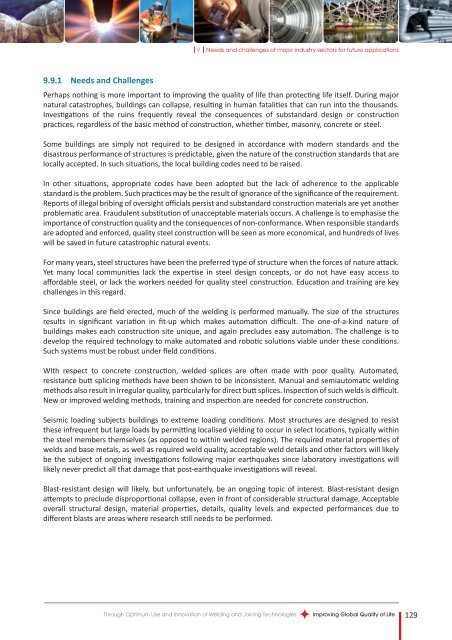Improving Global Quality of Life
Improving Global Quality of Life
Improving Global Quality of Life
You also want an ePaper? Increase the reach of your titles
YUMPU automatically turns print PDFs into web optimized ePapers that Google loves.
9 Needs and challenges <strong>of</strong> major industry sectors for future applications<br />
9.9.1 Needs and Challenges<br />
Perhaps nothing is more important to improving the quality <strong>of</strong> life than protecting life itself. During major<br />
natural catastrophes, buildings can collapse, resulting in human fatalities that can run into the thousands.<br />
Investigations <strong>of</strong> the ruins frequently reveal the consequences <strong>of</strong> substandard design or construction<br />
practices, regardless <strong>of</strong> the basic method <strong>of</strong> construction, whether timber, masonry, concrete or steel.<br />
Some buildings are simply not required to be designed in accordance with modern standards and the<br />
disastrous performance <strong>of</strong> structures is predictable, given the nature <strong>of</strong> the construction standards that are<br />
locally accepted. In such situations, the local building codes need to be raised.<br />
In other situations, appropriate codes have been adopted but the lack <strong>of</strong> adherence to the applicable<br />
standard is the problem. Such practices may be the result <strong>of</strong> ignorance <strong>of</strong> the significance <strong>of</strong> the requirement.<br />
Reports <strong>of</strong> illegal bribing <strong>of</strong> oversight <strong>of</strong>ficials persist and substandard construction materials are yet another<br />
problematic area. Fraudulent substitution <strong>of</strong> unacceptable materials occurs. A challenge is to emphasise the<br />
importance <strong>of</strong> construction quality and the consequences <strong>of</strong> non-conformance. When responsible standards<br />
are adopted and enforced, quality steel construction will be seen as more economical, and hundreds <strong>of</strong> lives<br />
will be saved in future catastrophic natural events.<br />
For many years, steel structures have been the preferred type <strong>of</strong> structure when the forces <strong>of</strong> nature attack.<br />
Yet many local communities lack the expertise in steel design concepts, or do not have easy access to<br />
affordable steel, or lack the workers needed for quality steel construction. Education and training are key<br />
challenges in this regard.<br />
Since buildings are field erected, much <strong>of</strong> the welding is performed manually. The size <strong>of</strong> the structures<br />
results in significant variation in fit-up which makes automation difficult. The one-<strong>of</strong>-a-kind nature <strong>of</strong><br />
buildings makes each construction site unique, and again precludes easy automation. The challenge is to<br />
develop the required technology to make automated and robotic solutions viable under these conditions.<br />
Such systems must be robust under field conditions.<br />
With respect to concrete construction, welded splices are <strong>of</strong>ten made with poor quality. Automated,<br />
resistance butt splicing methods have been shown to be inconsistent. Manual and semiautomatic welding<br />
methods also result in irregular quality, particularly for direct butt splices. Inspection <strong>of</strong> such welds is difficult.<br />
New or improved welding methods, training and inspection are needed for concrete construction.<br />
Seismic loading subjects buildings to extreme loading conditions. Most structures are designed to resist<br />
these infrequent but large loads by permitting localised yielding to occur in select locations, typically within<br />
the steel members themselves (as opposed to within welded regions). The required material properties <strong>of</strong><br />
welds and base metals, as well as required weld quality, acceptable weld details and other factors will likely<br />
be the subject <strong>of</strong> ongoing investigations following major earthquakes since laboratory investigations will<br />
likely never predict all that damage that post-earthquake investigations will reveal.<br />
Blast-resistant design will likely, but unfortunately, be an ongoing topic <strong>of</strong> interest. Blast-resistant design<br />
attempts to preclude disproportional collapse, even in front <strong>of</strong> considerable structural damage. Acceptable<br />
overall structural design, material properties, details, quality levels and expected performances due to<br />
different blasts are areas where research still needs to be performed.<br />
Through Optimum Use and Innovation <strong>of</strong> Welding and Joining Technologies<br />
<strong>Improving</strong> <strong>Global</strong> <strong>Quality</strong> <strong>of</strong> <strong>Life</strong><br />
129
















